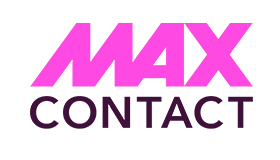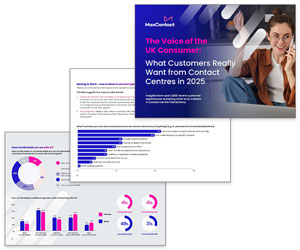Debt is no one’s favourite topic of conversation, but for a lot of contact centre staff, it’s all part of the job. However, how we talk about debt can make all the difference for both customers and staff.
By fostering a positive approach to conversations, contact centre staff can protect their wellbeing and have more positive customer interactions as well.
To talk more about it, MaxContact’s Sean McIver, Product Owner, joins Account Manager Andy Brooks in this webinar to discuss how to create and execute the best contact strategies for easier debt resolution.
Even before the pandemic, the average collection rate was below 20%, the lowest in 25 years. This, coupled with the cost-of-living crisis and rising debt levels, leaves teams balancing the need to collect debt efficiently and quickly while providing a great customer experience.
To learn how to execute the best contact strategies for debt resolution, watch the full webinar or keep reading.
As we head further into the cost-of-living crisis, more and more people are likely to wind up in debt. That means that contact centre staff responsible for working on debt resolution could be seeing increased levels of work coming their way.
With more people struggling with debt, it can be difficult to manage the expectations and emotions of customers who may be falling behind on payments. Andy and Sean share some tactics that help them.
The Importance of Open, Honest Conversations
While no one likes discussing debt, open, honest conversations are crucial to helping people resolve their debt issues.
One such solution is offering longer repayment periods, to split the debt up over a longer period to make payments more manageable. But this can only happen once you have an honest conversation with the customer about how much they can realistically afford.
By working with the customer to find a solution that works for them, you provide them with a much better experience.
Another way conversations are important in the debt collection process is when it comes to phone calls. When you speak with your bank or another institution on the phone, you often get asked a series of seemingly random questions.
As our webinar host Kayleigh explained, she had an awkward phone call with her bank about an issue and was left feeling uncertain and confused.
This is a great example of how organizations can rethink their approach to customer conversations. Something as simple as explaining why they’re asking for this information and what they plan on doing with it would have made Kayleigh feel a lot better about her call.
Preparing for Tough Times
Financial times are likely to get harder for a lot of people. With a looming recession, high inflation, and unmanageable energy bills, Andy says that contact centre staff should be prepared. Not just that, they should be proactive.
Andy suggests that debt collection staff should rethink strategies to fit in with the current climate. What may have worked years ago may no longer be effective.
Sean goes on further to say that data collection is key to staying on top of your strategy. By collecting, anonymising, and testing data, you can get a better understanding of how customers are doing and what strategies will work best for them.
“Nobody likes talking about being in debt. And yet, it’s affecting a vast number of people. If we can make those conversations positive, it will lead to a better customer interaction.” – Sean McIver, Product Owner, MaxContact
How to Manage the Effects on Contact Centre Staff
With more calls coming their way, contact centre staff need to be prepared to deal with customers on the front line.
Having tough calls with customers all day can take a toll on contact centre staff. That’s why it’s important to proactively watch out for their wellbeing and ensure they feel supported. With supported staff, you get better employee satisfaction, and you enable staff to do their best work – leading to happier customers.
Andy suggests, as a team, analysing customer calls and brainstorming how to improve the approach next time. By discussing what you can do to make the customer and the staff member feel better, you’ll make everyone much happier and more satisfied with the service.
Sean also suggests saving the more sensitive conversations for text-based communication. When tensions are high, having those conversations on the phone can lead to more frustration. Writing it all down in an email lets the recipient read it and respond once they’ve fully digested it. This could help to reduce the more difficult phone calls that staff handle.
He suggests you should also proactively protect the wellbeing of staff, which could be with check-ins and wellbeing reminders.
This is a particular challenge of remote work because people feel isolated. When you come off a particularly tricky call, you don’t have a team around you to support and talk about it.
So, Sean suggests doing whatever you can as a team to recreate those “water cooler moments.” By encouraging conversations on a more human level, not just about work, you can foster a more supportive environment for staff.
“Why aren’t we using more modern technology? Start embedding links into WhatsApp messages to payment sites so the customer can pay directly without ever needing to contact you.” Andy Brooks, Account Manager, MaxContact
How to Make Contact Strategies More Effective
To make strategies more effective, you need to become more efficient and understand your customers well. An old-fashioned letter and 30 phone calls isn’t going to cut it anymore. You need to be more efficient and targeted when talking to customers.
Andy says to be more efficient, you need to move away from doing everything manually. Don’t just pick up phones without having a contact platform in the background to support you. Instead, explore more efficient methods of communication such as automated reminders, texts, and WhatsApp messages as well.
If a customer has multiple creditors to deal with, they’re likely to prioritise the one that’s most understanding and easier to work with.
As well as having the right tools to manage customer interactions, it’s also important to understand your customers well.
Ask for things like preferred contact methods because you’ll find it easier to get in touch with people if you’re contacting them when they are available.
For example, a shop owner might not be available to take calls about debt when their shop is full of customers. They may prefer to have text messages within a certain timeframe when business is quieter.
By collecting data like this on your customers, you can start to build strategies based on what they need rather than a one-size-fits-all approach.
Finally, once you’ve got into the swing of collecting customer data and building solutions around them, don’t stop. Testing, analysing, and revisiting strategies should be ongoing. That way, you can stay on top of collections and always keep your customers’ needs and expectations in mind.
This blog post has been re-published by kind permission of MaxContact – View the Original Article
For more information about MaxContact - visit the MaxContact Website
Call Centre Helper is not responsible for the content of these guest blog posts. The opinions expressed in this article are those of the author, and do not necessarily reflect those of Call Centre Helper.
Author: MaxContact
Published On: 24th Nov 2022
Read more about - Guest Blogs, MaxContact






 MaxContact is the AI-powered customer engagement software that helps you turn every customer conversation into a high-impact, revenue-driving moment. We empower your teams to connect smarter, perform better, and scale faster – without losing the human touch.
MaxContact is the AI-powered customer engagement software that helps you turn every customer conversation into a high-impact, revenue-driving moment. We empower your teams to connect smarter, perform better, and scale faster – without losing the human touch. 
































